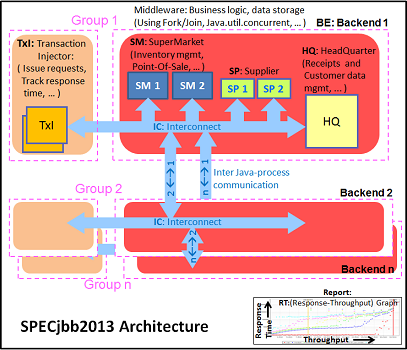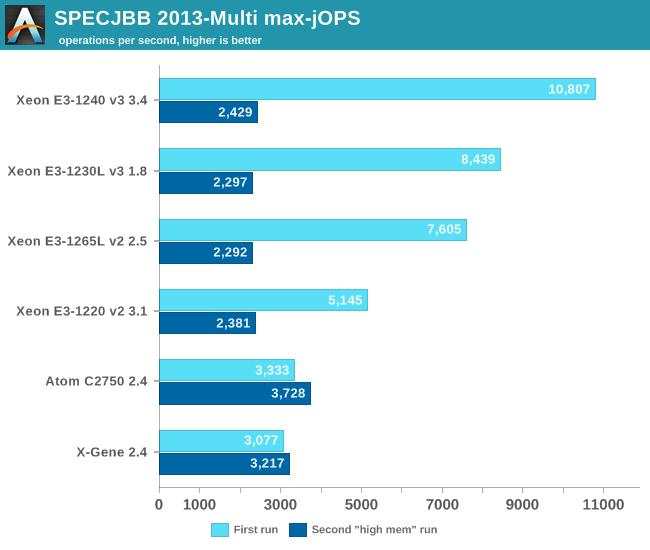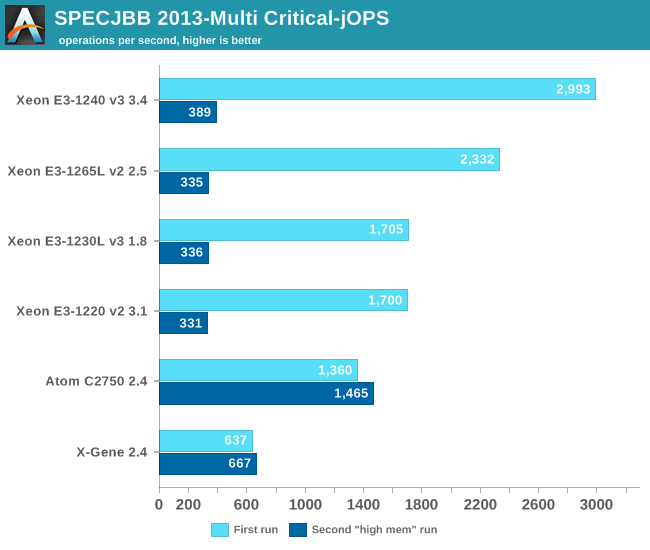X-Gene 1, Atom C2000 and Xeon E3: Exploring the Scale-Out Server World
by Johan De Gelas on March 9, 2015 2:00 PM ESTJava Server Performance
The SPECjbb 2013 benchmark has "a usage model based on a world-wide supermarket company with an IT infrastructure that handles a mix of point-of-sale requests, online purchases, and data-mining operations." It uses the latest Java 7 features and makes use of XML, compressed communication, and messaging with security.

We tested with four groups of transaction injectors and back-ends. We applied a relatively basic tuning to mimic real-world use. Our first run was done with a low amount of memory:
"-server -Xmx4G -Xms4G -Xmn2G -XX:+AlwaysPreTouch -XX:+UseLargePages"
With these settings, the benchmark takes about 20-27GB of RAM. In our second run, we doubled the amount of memory to see if more memory (64GB vs. 32GB) can boost performance even more:
"-server -Xmx8G -Xms8G -Xmn4G -XX:+AlwaysPreTouch -XX:+UseLargePages"
With these settings, the benchmark takes about 43-57GB of RAM. The first metric is basically maximum throughput.

Assigning more memory to your Java VMs than what you have available is of course a bad idea, but now we have some numbers you can use to convince you coworkers of this fact. Although the Atom C2750 and X-Gene perform a little better thanks to fact that they can address twice as much RAM, they are nowhere near the performance of a Xeon E3-1230L if the latter is configured properly.
The Critical-jOPS metric is a throughput metric under response time constraint.

The Xeon E3 Haswell core continues to outperform the Atom by a tangible margin. The X-Gene fails to compete with the Intel SoCs. The conclusion is pretty simple: Java applications run best on a Haswell or Ivy Bridge core.










47 Comments
View All Comments
Wilco1 - Tuesday, March 10, 2015 - link
GCC4.9 doesn't contain all the work in GCC5.0 (close to final release, but you can build trunk). As you hinted in the article, it is early days for AArch64 support, so there is a huge difference between a 4.9 and 5.0 compiler, so 5.0 is what you'd use for benchmarking.JohanAnandtech - Tuesday, March 10, 2015 - link
You must realize that the situation in the ARM ecosystem is not as mature as on x86. the X-Gene runs on a specially patched kernel that has some decent support for ACPI, PCIe etc. If you do not use this kernel, you'll get in all kinds of hardware trouble. And afaik, gcc needs a certain version of the kernel.Wilco1 - Tuesday, March 10, 2015 - link
No you can use any newer GCC and GLIBC with an older kernel - that's the whole point of compatibility.Btw your results look wrong - X-Gene 1 scores much lower than Cortex-A15 on the single threaded LZMA tests (compare with results on http://www.7-cpu.com/). I'm wondering whether this is just due to using the wrong compiler/options, or running well below 2.4GHz somehow.
JohanAnandtech - Tuesday, March 10, 2015 - link
Hmm. the A57 scores 1500 at 1.9 GHz on compression. The X-Gene scores 1580 with Gcc 4.8 and 1670 with gcc 4.9. Our scores are on the low side, but it is not like they are impossibly low.Ubuntu 14.04, 3.13 kernel and gcc 4.8.2 was and is the standard environment that people will get on the the m400. You can tweak a lot, but that is not what most professionals will do. Then we can also have to start testing with icc on Intel. I am not convinced that the overall picture will change that much with lots of tweaking
Wilco1 - Tuesday, March 10, 2015 - link
Yes, and I'd expect the 7420 will do a lot better than the 5433. But the real surprise to me is that X-Gene 1 doesn't even beat the A15 in Tegra K1 despite being wider, newer and running at a higher frequency - that's why the results look too low.I wouldn't call upgrading to the latest compiler tweaking - for AArch64 that is kind of essential given it is early days and the rate of development is extremely high. If you tested 32-bit mode then I'd agree GCC 4.8 or 4.9 are fine.
CajunArson - Tuesday, March 10, 2015 - link
This is all part of the problem: Requiring people to use cutting edge software with custom recompilation just to beat a freakin' Atom much less a real CPU?You do realize that we could play the same game with all the Intel parts. Believe me, the people who constantly whine that Haswell isn't any faster than Sandy Bridge have never properly recompiled computationally intensive code to take advantage of AVX2 and FMA.
The fact that all those Intel servers were running software that was only compiled for a generic X86-64 target without requiring any special tweaking or exotic hacking is just another major advantage for Intel, not some "cheat".
Klimax - Tuesday, March 10, 2015 - link
And if we are going for cutting edge compiler, then why not ICC with Intel's nice libraries... (pretty sure even ancient atom would suddenly look not that bad)Wilco1 - Tuesday, March 10, 2015 - link
To make a fair comparison you'd either need to use the exact same compiler and options or go all out and allow people to write hand optimized assembler for the kernels.68k - Saturday, March 14, 2015 - link
You can't seriously claim that recompiling an existing program with a different (well known and mature) compiler is equal to hand optimize things in assembler. Hint, one of the options is ridiculous expensive, one is trivial.aryonoco - Monday, March 9, 2015 - link
Thank you Johan. Very very informative article. This is one of the least reported areas of IT in general, and one that I think is poised for significant uptake in the next 5 years or so.Very much appreciate your efforts into putting this together.